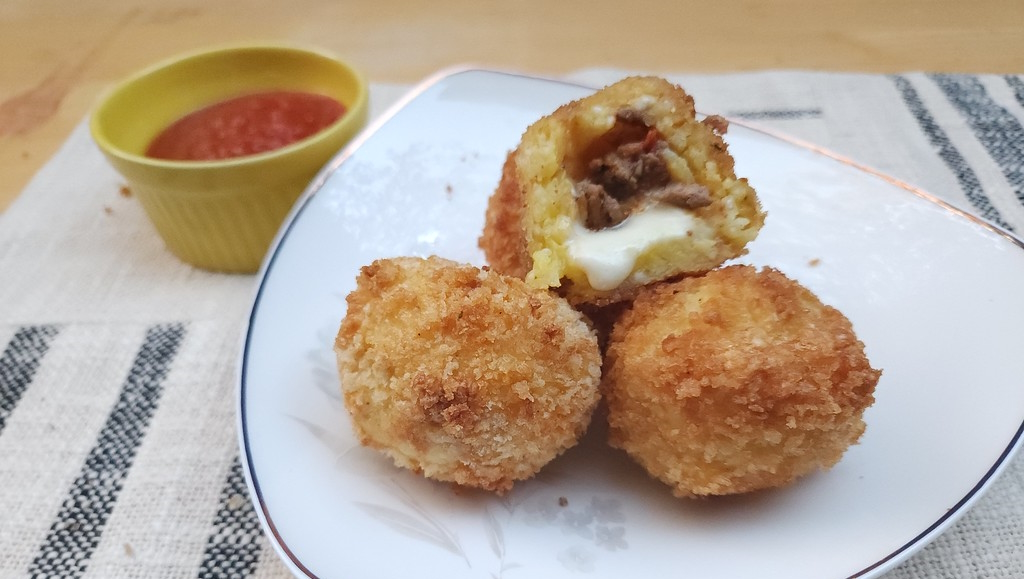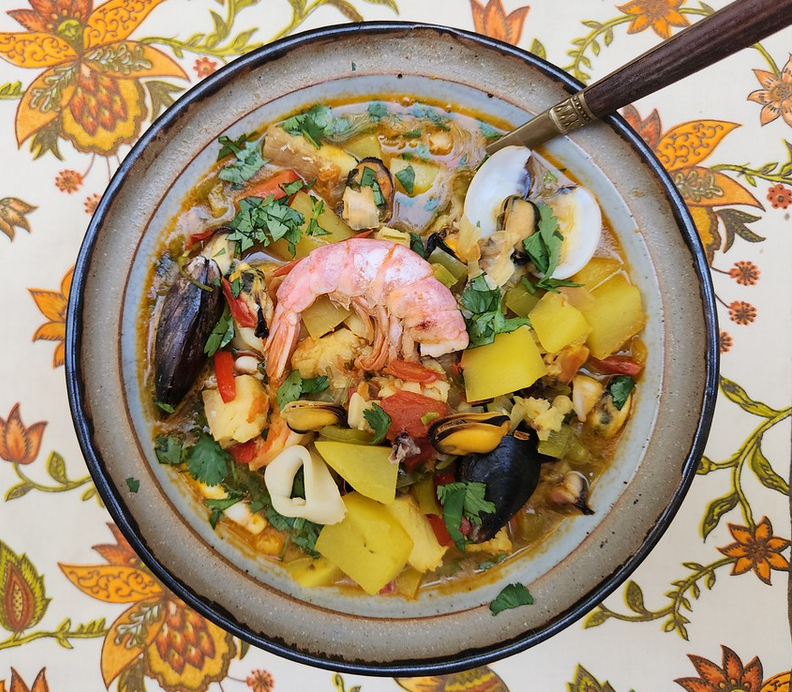Our recipe of the month is for Paraguayan Vori-Vori, a traditional soup featuring soft, cheese-infused cornmeal dumplings served in a rich, flavorful broth. Soup is a very common dish in Paraguay and vori-vori is one of the most enjoyed soups and the wonderful culinary website TasteAtlas crowned it "The Best Soup of the World" for 2025!

Paraguay, a landlocked country in South America, boasts a rich culinary tradition influenced by indigenous Guaraní, Afro-Paraguayan and Euro-Paraguayan cultures. One of its most beloved dishes is vori-vori, a hearty and comforting soup made with small dumplings crafted from cornmeal and cheese, simmered in a chicken broth.
Vori-Vori is often enjoyed as a home-cooked meal, particularly during colder months, when its warmth and rich flavors provide comfort. It is also commonly served as a starter in larger meals or as a standalone dish when made in larger portions.
In a larger social context, Vori-Vori is often associated with family gatherings and communal cooking, where multiple generations participate in rolling the dumplings, reinforcing family bonds and passing down culinary traditions. It a staple at celebrations, religious festivals, and even political events where traditional Paraguayan foods are served as symbols of national pride. And, vori-vori is a common dish in Paraguayan traditional restaurants (comedor típico).
The name “Vori-Vori” originates from the Guaraní language, in which the word “vori” refers to a ball or round object, which perfectly describes the shape of the dumplings. The use of cheese in combination with corn flour or corn meal is also hallmark of Paraguayan cooking.
In Paraguay, the cheese most used for vori-vori is "kesú paraguai" which is a nativized (Gurani) transformation of the Spanish words "queso" and "Paraguay". The cheese most like kesú paraguai is Mexican queso panela (which I used) but perhaps queso fresco would work too. In a pinch you can use Monterey Jack.
The images I found researching this dish show quite a range of sizes for the cornmeal/cheese ball, but recipe texts typically call for vori-vori dumplings that are slightly larger than a standard marble (1/2" to 3/4" diameter).
Cooks Notes:
I couldn't find corn flour at either grocery store I went to. I did have some cornmeal on hand so I ground is finer in a mini-blender. While the result was much finer, once it was mixed with water, it was still a bit grainy. Apparently, many people outside of Paraguay use nixtamalized corn flour (masa harina) but this also results in a different texture than plain corn flour. Fine corn meal not only is grainier than either masa harina or plain corn flour, but it is less cohesive. I ended up using an egg and a small amount of wheat flour to make it less crumbly.
The vori-vori I made were a bit on the dense side. I had used an equal ratio of corn flour to pandela cheese. In the recipe below I halved the cheese which should make the vori-vori fluffier.
I put the pandela cheese in the freezer for 15 minutes and then pulverized it in my mini blender. If you prefer, you can shred it finely.
I added peeled and cubed acorn squash, a common addition. To make peeling easier I microwaved the entire squash for 2 minutes to make peeling easier. Then I cut the squash into and then quarters, removed the seeds and surrounding membranes and then peeled the skin off with a small paring knife before cutting the squash into 1 1/2" pieces.
As is frequently the case, most recipes for soups or stews add all the vegetables to the soup at the same time. This is sub-optimal because not all roots and vegetables become tender in the same amount of time. Our recipe calls for adding vegetables in five-minute intervals (after the chicken has simmered for 30 minutes) in a specific sequence based on how long each vegetable or root takes to become tender. If you use rotisserie or pre-cooked chicken, you can cut the simmering of the chicken to ten minutes before you start adding the vegetables.
Ingredients:
For the Dumplings:
- 1 cup corn flour or cornmeal (fine, not course)
- 1/2 cup grated cheese (Paraguayan cheese, pandela, or Monterey Jack)
- 1 tablespoon butter (optional, for extra richness)
- 1 egg (optional, if using corn meal)
- Sufficient soup broth or water to make the mixture into dough that is wet enough to make the vori-vori balls.
- 1-2 teaspoons of salt (less if you are using broth).
For the Broth:
- 2 pounds of chicken (we used rotisserie cooked chicken breast, use whatever suits you)
- 1 onion, finely chopped
- 2 garlic cloves, minced
- 2 carrots, peeled and sliced thick
- 1 acorn or some other kind of squash
- 1 acorn squash (optional)
- 1 red bell pepper, chopped
- 1 tomato, chopped
- 6 cups chicken broth or water
- 2 tablespoons vegetable oil or butter
- 2 teaspoon ground cumin (or more if you prefer)
- 2 teaspoons salt, or to taste
- 1 teaspoon black pepper
- 1 bay leaf
- Fresh parsley or cilantro, chopped (for garnish)
Preparation:
- Grate or pulverize the cheese.
- In a mixing bowl, combine the cheese, corn flour (or meal), egg, and water to make the dough.
- Heat the oil on medium in a large pot.
- Lightly Brown the chicken and onions in the pot, adding the garlic at the end.
- Fill the pot with the broth, bring it to a boil and then lower it to a simmer.
- Set a timer for 30 minutes.
- Add the acorn squash.
- Set a timer for 5 minutes.
- Add the carrots. Kli> Set a timer for 5 minutes.
- Start making the vori-vori dough balls, setting the completed ones aside on a plate
- Set a timer for 5 minutes.
- Add the red peppers and vori-vori balls.
- Wait until all the balls float to the surface (5 - 7 minutes).
- Test for vegetable doneness, simmer longer if needed.
Garnish with chopped cilantro or parsley and serve hot, accompanied by crusty bread, or chipa (a cheesy roll) for an authentic Paraguayan experience.
Recipe by T. Johnston-O'Neill
Photos by Shari K. Johnston-O'Neill









